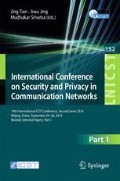Abstract
The prevalence of smartphone makes it more important in people’s business and personal life which also helps it to be a target of the malware. In this paper, we introduce a new kind of attack called Function Escalation Attack which obtains functions locally or remotely. We present three threat models: Steganography, Collusion Attack and Code Abusing. A vulnerability in Android filesystem which is used in code abusing threat model is exposed as well. Three proof-of-concept malicious apps are implemented for each threat model. They could bypass static analysis and dynamic analysis. The result shows that function escalation attack could successfully perform malicious tasks such as taking pictures, recording audio and so on.
Access this chapter
Tax calculation will be finalised at checkout
Purchases are for personal use only
References
Enck, W., Gilbert, P., Chun, B.G., Cox, L.P., Jung, J., McDaniel, P., Sheth, A.N.: Taintdroid: an information-flow tracking system for realtime privacy monitoring on smartphones. In: Proceedings of the 9th USENIX Conference on Operating Systems Design and Implementation. OSDI 2010, pp. 1–6. USENIX Association, Berkeley (2010)
Bugiel, S., Davi, L., Dmitrienko, A., Fischer, T., d Sadeghi, A.R.: Xmandroid: a new android evolution to mitigate privilege escalation attacks. Technical report TR-2011-04, Technische Universität Darmstadt (2011)
Lu, L., Li, Z., Wu, Z., Lee, W., Jiang, G.: Chex: statically vetting android apps for component hijacking vulnerabilities. In: Proceedings of the 2012 ACM Conference on Computer and Communications Security, pp. 229–240. ACM (2012)
Kim, J., Yoon, Y., Yi, K., Shin, J., Center, S.: Scandal: static analyzer for detecting privacy leaks in android applications. In: MoST (2012)
Tenenboim-Chekina, L., Barad, O., Shabtai, A., Mimran, D., Rokach, L., Shapira, B., Elovici, Y.: Detecting application update attack on mobile devices through network features. In: The 32nd IEEE International Conference on Computer Communications (2013)
Google Play Developer Program Policies. https://play.google.com/about/developer-content-policy.html. Accessed March 2014
Android Security Overview. http://source.android.com/devices/tech/security/index.html. Accessed March 2014
Enck, W., Ongtang, M., McDaniel, P.D., et al.: Understanding android security. IEEE Secur. Priv. 7(1), 50–57 (2009)
Felt, A.P., Chin, E., Hanna, S., Song, D., Wagner, D.: Android permissions demystified. In: Proceedings of the 18th ACM Conference on Computer and Communications Security, pp. 627–638. ACM (2011)
Dexclassloader. http://developer.android.com/reference/dalvik/system/DexClassLoader.html. Accessed March 2014
Google, G.S.: Inside the android application framework (2008). https://sites.google.com/site/io/inside-the-android-application-framework
Petitcolas, F.A., Anderson, R.J., Kuhn, M.G.: Information hiding-a survey. Proc. IEEE 87(7), 1062–1078 (1999)
Rfc 2083. http://tools.ietf.org/html/rfc2083
Marforio, C., Ritzdorf, H., Francillon, A., Capkun, S.: Analysis of the communication between colluding applications on modern smartphones. In: Proceedings of the 28th Annual Computer Security Applications Conference, pp. 51–60. ACM (2012)
Android-apktool. https://code.google.com/p/android-apktool/
Dexdeps. https://android.googlesource.com/platform/dalvik.git/+/android-4.2.2_r1/tools/dexdeps
Google, I.: Android market share. http://developer.android.com/about/dashboards/index.html. Accessed March 2014
Baidu Map. http://map.baidu.com/
Youdao Dictionary. http://cidian.youdao.com/mobile.html
Youdao Clound Note. https://note.youdao.com/index.html
Enck, W., Ongtang, M., McDaniel, P.: Mitigating android software misuse before it happens. Technical Report NAS-TR-0094-2008, Network and Security Research Center, Department of Computer Science and Engineering, Pennsylvania State University, University Park, PA, USA (2008)
Enck, W., Ongtang, M., McDaniel, P.: On lightweight mobile phone application certification. In: Proceedings of the 16th ACM Conference on Computer and Communications Security, pp. 235–245. ACM (2009)
Zhang, Y., Yang, M., Xu, B., Yang, Z., Gu, G., Ning, P., Wang, X.S., et al.: Vetting undesirable behaviors in android apps with permission use analysis. In: Proceedings of the 2013 ACM SIGSAC Conference on Computer and Communications Security, pp. 611–622. ACM (2013)
Shabtai, A., Fledel, Y., Elovici, Y.: Securing android-powered mobile devices using selinux. IEEE Secur. Priv. 8(3), 36–44 (2010)
An analysis of the anserverbot trojan. http://www.csc.ncsu.edu/faculty/jiang/pubs/AnserverBot_Analysis.pdf
Grace, M., Zhou, Y., Zhang, Q., Zou, S., Jiang, X.: Riskranker: scalable and accurate zero-day android malware detection. In: Proceedings of the 10th International Conference on Mobile Systems, Applications, and Services, pp. 281–294. ACM (2012)
Poeplau, S., Fratantonio, Y., Bianchi, A., Kruegel, C., Vigna, G.: Execute this! analyzing unsafe and malicious dynamic code loading in android applications. In: NDSS, vol. 14, pp. 23–26 (2014)
Felt, A.P., Wang, H.J., Moshchuk, A., Hanna, S., Chin, E.: Permission re-delegation: attacks and defenses. In: USENIX Security Symposium (2011)
Davi, L., Dmitrienko, A., Sadeghi, A.-R., Winandy, M.: Privilege escalation attacks on android. In: Burmester, M., Tsudik, G., Magliveras, S., Ilić, I. (eds.) ISC 2010. LNCS, vol. 6531, pp. 346–360. Springer, Heidelberg (2011)
Schlegel, R., Zhang, K., Zhou, X.Y., Intwala, M., Kapadia, A., Wang, X.: Soundcomber: a stealthy and context-aware sound trojan for smartphones. In: NDSS, vol. 11, pp. 17–33 (2011)
Owusu, E., Han, J., Das, S., Perrig, A., Zhang, J.: Accessory: password inference using accelerometers on smartphones. In: Proceedings of the Twelfth Workshop on Mobile Computing Systems and Applications, p. 9. ACM (2012)
Xu, Z., Bai, K., Zhu, S.: Taplogger: Inferring user inputs on smartphone touchscreens using on-board motion sensors. In: Proceedings of the Fifth ACM Conference on Security and Privacy in Wireless and Mobile Networks, pp. 113–124. ACM (2012)
Templeman, R., Rahman, Z., Crandall, D., Kapadia, A.: Placeraider: virtual theft in physical spaces with smartphones (2012). arXiv preprint, arXiv:1209.5982
Wang, T., Lu, K., Lu, L., Chung, S., Lee, W.: Jekyll on ios: when benign apps become evil. In: Presented as Part of the 22nd USENIX Security Symposium (USENIX), pp. 559–572 (2013)
Acknowledgement
This research is supported by National Natural Science Foundation of China [61272481].
Author information
Authors and Affiliations
Corresponding author
Editor information
Editors and Affiliations
Rights and permissions
Copyright information
© 2015 Institute for Computer Sciences, Social Informatics and Telecommunications Engineering
About this paper
Cite this paper
Cao, C., Zhang, Y., Liu, Q., Wang, K. (2015). Function Escalation Attack. In: Tian, J., Jing, J., Srivatsa, M. (eds) International Conference on Security and Privacy in Communication Networks. SecureComm 2014. Lecture Notes of the Institute for Computer Sciences, Social Informatics and Telecommunications Engineering, vol 152. Springer, Cham. https://doi.org/10.1007/978-3-319-23829-6_33
Download citation
DOI: https://doi.org/10.1007/978-3-319-23829-6_33
Published:
Publisher Name: Springer, Cham
Print ISBN: 978-3-319-23828-9
Online ISBN: 978-3-319-23829-6
eBook Packages: Computer ScienceComputer Science (R0)

